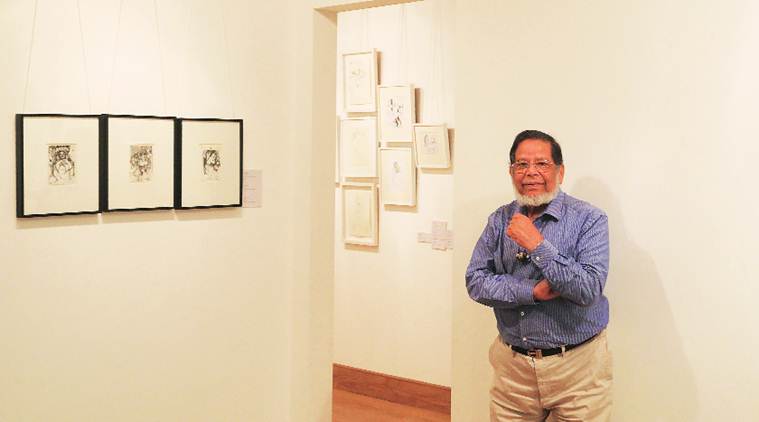Sometimes, the canvas guides you: Sakti Burman
Veteran artist Sakti Burman, currently showing 60 years of his watercolours at an exhibition in Delhi, on his varied influences and painting fantasies
 The artist with some of his works at the Delhi exhibition (Express Photo: Abhinav Saha)
The artist with some of his works at the Delhi exhibition (Express Photo: Abhinav Saha)
Drawing extensively from the East and the West, Sakti Burman is known to seamlessly merge myth and reality. Painted in vivid colours, his works are often populated with mythical and mythological figures.
Shuttling between Paris and Delhi, the artist is currently showing six decades of his watercolour and pen and ink works at Art Alive Gallery in Delhi. Burman, 84, talks about his varied influences and painting fantasies.
Excerpts:
I was reading how in the ’60s when you were in Paris and would exhibit at Pundole Art Gallery in Mumbai, most of the works used to be watercolours. Does this exhibition remind you of that time?
I showed at Pundole for years. Watercolours were easier to carry, which is why I would mostly exhibit those. I would experiment with them, not just the subject but also how I painted. Now, I don’t use watercolour that much but I draw and sketch a lot.
Until recently, I used to carry my sketchbook everywhere I went. In this exhibition, there are several of my drawing and sketches. I would just make them and forget about them. Maite (his wife) would keep them properly.
Among the earliest works in the exhibition, from the ’50s, are two large watercolours, Through the Gate of Udaipur and Kashmir. Over the years, you have continued to paint your travels.
The works in the ’50s were made when I was still an art student in Kolkata. I would travel with two or three friends. We painted what we saw. We often travelled to Delhi too, where we would stay at the polytechnic in Old Delhi and travel to Qutub Minar to paint the monument. We used to also go to the railway station.
Travelling allows you to observe different cultures. I had read about the frescoes in Italy but when I travelled there (in the late ’50s) and encountered the frescoes of artists such as Giotto, Piero della Francesca and Simone Martini, it inspired me to bring that effect and texture in my works. The few years of my childhood that I spent in Bidyakut (Bangladesh) are also nostalgic. I have not been there for years, but I am told the place the changed.
Though you moved to France in your twenties, you often exhibited in India. For some years now, you spend the winter in Delhi, where you have a home.
There are people who appreciate my work here, which is why I always continued to exhibit in India. I recall having a thought many years ago if I should move back to India, but many people around me were of the opinion that life will be more difficult here.
Some years ago, I decided to buy a house in Delhi, and that makes it easier for us to come and stay here for months. Last year, the gallery I worked with in Paris also shut. I had some proposals but I haven’t taken anything yet.
Last time we met, you had shared childhood memories of admiring your brother draw. When did you decide you wanted to pursue art?
When my brother drew, I would intently watch him but I also used to draw a lot as a child. When I was in school, I began doing larger drawings and that perhaps led me to painting. During the freedom movement, I made portraits of Gandhiji and Nehru. Once Nehru was in Dibrugarh and was delivering a lecture, I showed him a portrait I had done, which he very graciously signed. He had a beautiful handwriting. I was looking for that portrait recently but unfortunately I seem to have lost it.
My teachers used to appreciate my drawings in school and encouraged me to join art school. My father had several businesses, which my brothers continued. When I shared my desire to study art, they were all concerned about my future but were happy I was doing something different. Thankfully, things fell in place. I got admission in France. I was able to devote time to my art; I only worked as a designer in a textile house briefly.
We also see a lot of mythological characters in your works but you borrow the characters not the stories.
I build my own stories. Sometimes the canvas guides you. There are figures from Greek and Indian mythology — Shiva, Krishna — and I paint scenes around them. You see my memories in my works. As a child, I was fascinated with Pandora’s casket.
In English literature, I read stories from Greek and Roman mythology. When I went to Egypt and Greece, I was searching for these stories, but obviously things don’t stay the same. In my works, I also bring in fantasy, which has Indian and Western influences.
In your fantastical depictions there is no violence. Is that deliberate?
I don’t like violence, we see so much of it around us. I am not a Gandhian but I do support his philosophy of non-violence. In some of the works I painted guns but that’s because people would question why I wasn’t depicting violence. I like to create layered works and have often used mirror as a metaphor for reflection — intended for people to ponder on what they see.




- 01
- 02
- 03
- 04
- 05























